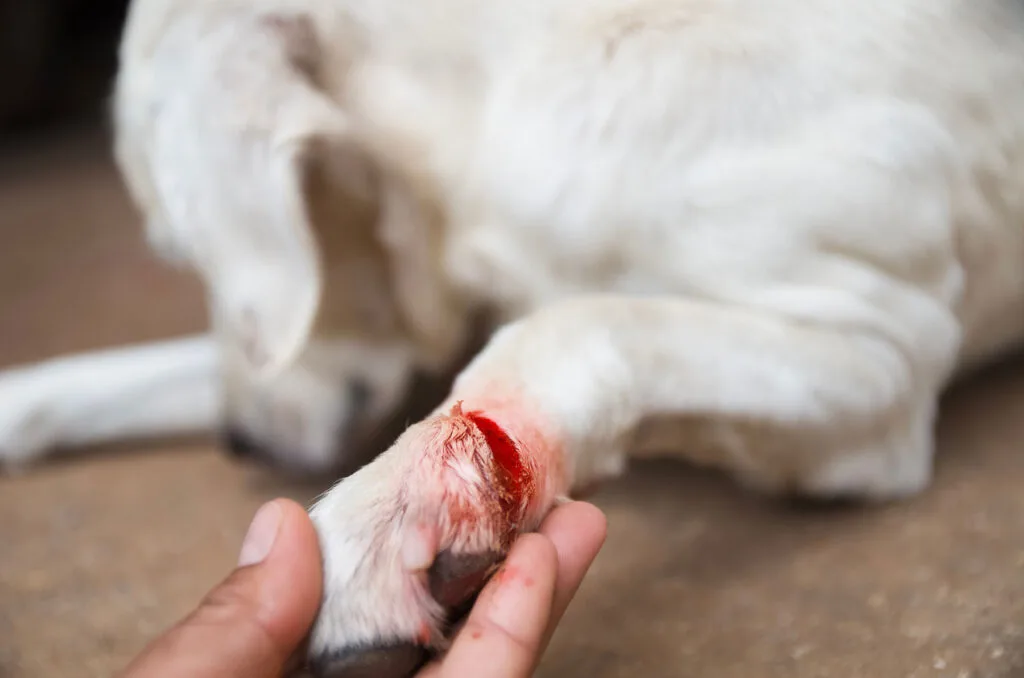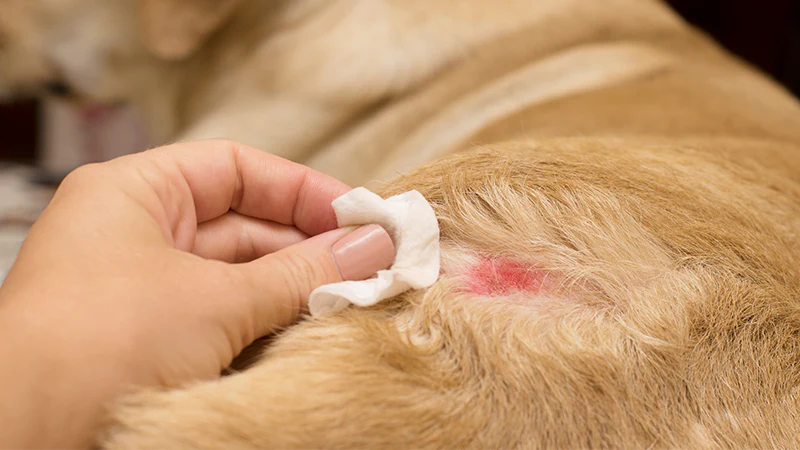Dogs are by nature curious and significantly active, a situation which makes them more prone to minor cuts, scrapes, and wounds as these become a part of their life. There are some preventive measures for how to clean a dog wound. Whether your dog plays outside and somehow gets a small scratch or has a deeper wound obtained by accident, the most important thing is to know how to properly clean and take care of it, which will help prevent infections and speed up the healing process. In this guide, we take you step by step through what cleaning a dog wound safely and effectively is.
Understand The Types of Wounds in Dogs
Dog wounds can come in different types, like cuts, scrapes, punctures, and bites, and each of them requires special care and special techniques to avoid infection. These curable wound brands are such as cuts, abrasions, and wide-open flesh wounds. On the contrary, critical wound brands can be caused by deep cuts, bleeding, and coming into contact of wound with an infected area. Stay with us and learn how to clean a dog wound!
- Scrapes and Abrasions – Superficial wounds caused by friction against rough surfaces.
- Puncture Wounds – Bites, sharp objects, or insect stings often cause deeper wounds.
- Lacerations and Cuts – Tears or deep cuts in the skin, often requiring stitches.
- Burns – Can be caused by heat, chemicals, or friction.
- Abscesses – Pockets of pus resulting from infections.
When to Seek Veterinary Help After Wound
Learn how to clean a dog wound with proper care at home, but others will require immediate treatment by a vet. Deep cuts, large blood volume complications, stab wounds to the body, and infection signals, which include redness, pus, or swelling, should be attended to as soon as possible to avoid the worst. The most common injury that results from any accident is a wound characterized by skin breakage. The wound may not be attainable, yet some animal diseases can escalate if not treated in a timely manner.
If your dog’s wound is bleeding so much and the bleeding does not stop within 5-10 minutes, or if it is so deep that it goes through the muscle, bone, or tendon, immediate medical attention is required. You may suspect that this injury comes from a puncture wound with unknown sources, and it poses a high infection risk. However, be sure to see the vet if symptoms like redness, swelling, or possibly a bad odor are present around the area. Sensitive areas like the eyes, genitals, or joints are vulnerable and require special protection. Other symptoms, including severe pain, lethargy, or fever, are serious enough to warrant immediate professional attention.
Preparing to Clean the Wound
Before understanding how to clean a dog wound, gather essential supplies like antiseptic solution, sterile gauze, and gloves to ensure a safe and hygienic process. Since injured dogs may be anxious or in pain, speak to them in a calm, reassuring tone and gently restrain them if necessary. Ensuring your dog feels secure will make the cleaning process smoother and less stressful for both of you.
You Might Also Like: How To Pass A Hair Follicle Test For Truck Drivers
Gather Necessary Supplies
Having all the necessary supplies ready will make the wound-cleaning process smooth and stress-free. You’ll need clean towels or gauze pads, saline solution or lukewarm water, and an antiseptic solution like chlorhexidine or povidone-iodine. Keep antibacterial ointment, cotton balls, or soft cloth on hand, along with blunt-end scissors for trimming the fur around the wound. If needed, have bandages ready, and don’t forget treats to comfort and reward your dog after the process.
Ensuring Your Dog’s Comfort and Safety
Keep your dog calm by speaking in a soothing and reassuring tone throughout the process. If they seem anxious, have someone gently hold or distract them to make them feel secure. In cases where your dog may react out of fear or pain, consider using a muzzle to prevent accidental bites. Work slowly and carefully after learning how to clean a dog wound, ensuring a stress-free experience for both you and your pet.
Step-by-Step Guide to Cleaning a Dog Wound
Cleaning your dog’s wound properly is essential to prevent infection and promote healing. By following a careful step-by-step approach, you can ensure your furry friend stays safe and comfortable. Here’s how to clean a dog wound effectively while keeping them calm and stress-free.
Restrain Your Dog Gently
Make sure your dog is in a comfortable position. If needed, have someone assist by holding them gently but firmly. If your dog tends to struggle, wrapping them in a towel (leaving the wound exposed) may help keep them still.
Trim Hair Around the Wound (If Needed)
If there is fur around the wound, carefully trim it with blunt-end scissors to prevent hair from getting into the wound. Be extra cautious to avoid causing additional injury.
Rinse with Clean Water or Saline Solution
Use lukewarm water or a saline solution to flush out any dirt, debris, or bacteria. You can do this gently by knowing how to clean a dog wound and pouring the solution over the wound or using a clean syringe to flush it out. Avoid using hydrogen peroxide, as it can damage healthy tissue.
Clean with An Antiseptic Solution
Dampen a clean gauze pad or cotton ball with an antiseptic solution (like chlorhexidine or povidone-iodine) and gently dab the wound. Avoid alcohol-based solutions, as they can sting and irritate the wound.
Apply an Antibacterial Ointment
Once the wound is clean and dry, apply a thin layer of antibacterial ointment to promote healing and prevent infection. Avoid using human creams, as some ingredients can be toxic to dogs.
Bandage the Wound (If Required)
Not all wounds need to be covered, but if the wound is deep, in a high-contact area, or your dog tends to lick it, covering it with a sterile bandage can help. Use a non-stick dressing and secure it with vet wrap or gauze, ensuring it’s not too tight.
Aftercare and Monitoring Of Dog’s Wound
After understanding how to clean a dog wound cleaning wound, ongoing care is crucial to ensure proper healing and prevent infection. Regularly check for signs of redness, swelling, or discharge, and keep the wound clean and dry. Monitoring your dog’s behaviour and keeping them from licking or scratching the area will help speed up recovery.
Preventing Infection and Complications
Check your dog’s wound daily for any signs of infection, such as redness, swelling, pus, or a foul smell. Keep the area clean and dry, and prevent licking by using an Elizabethan collar if necessary. If bandages are used, change them regularly and reapply antibacterial ointment to promote healing.
Signs of Infection to Watch For Dog’s Wound
If you notice increased redness or swelling, foul-smelling discharge, or persistent licking and scratching, your dog may have an infection. Signs like fever, lethargy, or loss of appetite also indicate a need for urgent veterinary attention. Always seek professional care if the wound worsens or doesn’t heal properly.

What to Avoid When Treating a Dog Wound
When treating a dog after learning how to clean a dog wound, some common mistakes can slow healing or worsen the injury. Avoid using harsh chemicals like hydrogen peroxide or alcohol, as they can damage healthy tissue. Refrain from removing scabs too soon or letting your dog lick the wound excessively, as this can delay recovery and increase the risk of infection.
Using Hydrogen Peroxide or Alcohol – These can delay healing by damaging healthy tissue.
Applying Human Medications – Some ingredients in human creams, like hydrocortisone, can be toxic to dogs.
Over-Bandaging the Wound – Wrapping too tightly can restrict circulation and slow healing.
Ignoring Behavioral Changes – If your dog is lethargic, in pain, or not acting normally, seek professional advice.
When to Take Your Dog to the Vet
While minor wounds can often be treated at home, some situations require veterinary attention. If the wound is deep, bleeding excessively, or near sensitive areas, seeking professional care is crucial. Signs of infection, such as swelling, pus, or foul odor, indicate the need for medical intervention. Additionally, if your dog is in significant pain, limping, or acting unusually, or if a bite or rusty object caused the wound, a vet visit is essential to prevent complications like tetanus or rabies.
Preventing Future Injuries
While accidents are inevitable, you can minimize the risk of wounds by keeping your home and yard free of sharp objects and hazards. Supervise your dog during rough play or new explorations, ensure proper grooming to prevent skin issues, and keep their nails trimmed to avoid accidental scratches. Regular vet check-ups for the sake of knowledge of how to clean a dog wound also help monitor overall health and catch potential issues early.
Frequently Asked Questions
How Do I Stop My Dog From Licking The Wound?
Use an Elizabethan collar (E-collar) or a pet-friendly wound covering to prevent licking.
When Should I Take My Dog To The Vet For A Wound?
Seek vet care if the wound is deep, bleeding heavily, showing infection signs, or if your dog is in pain.
Can I Bandage My Dog’s Wound At Home?
Yes, but only if needed. Ensure it’s clean, apply antibacterial ointment, and avoid wrapping too tightly.
Conclusion
Caring for and learning how to clean a dog wound properly ensures a faster recovery and reduces the risk of infections. By following the right steps—from cleaning to aftercare—you can help your furry friend heal safely and comfortably. Always monitor the wound for signs of infection and take preventive measures to avoid future injuries. If the wound worsens or your dog shows signs of distress, don’t hesitate to seek veterinary help.




[…] You Might Also Like: How To Clean A Dog Wound […]